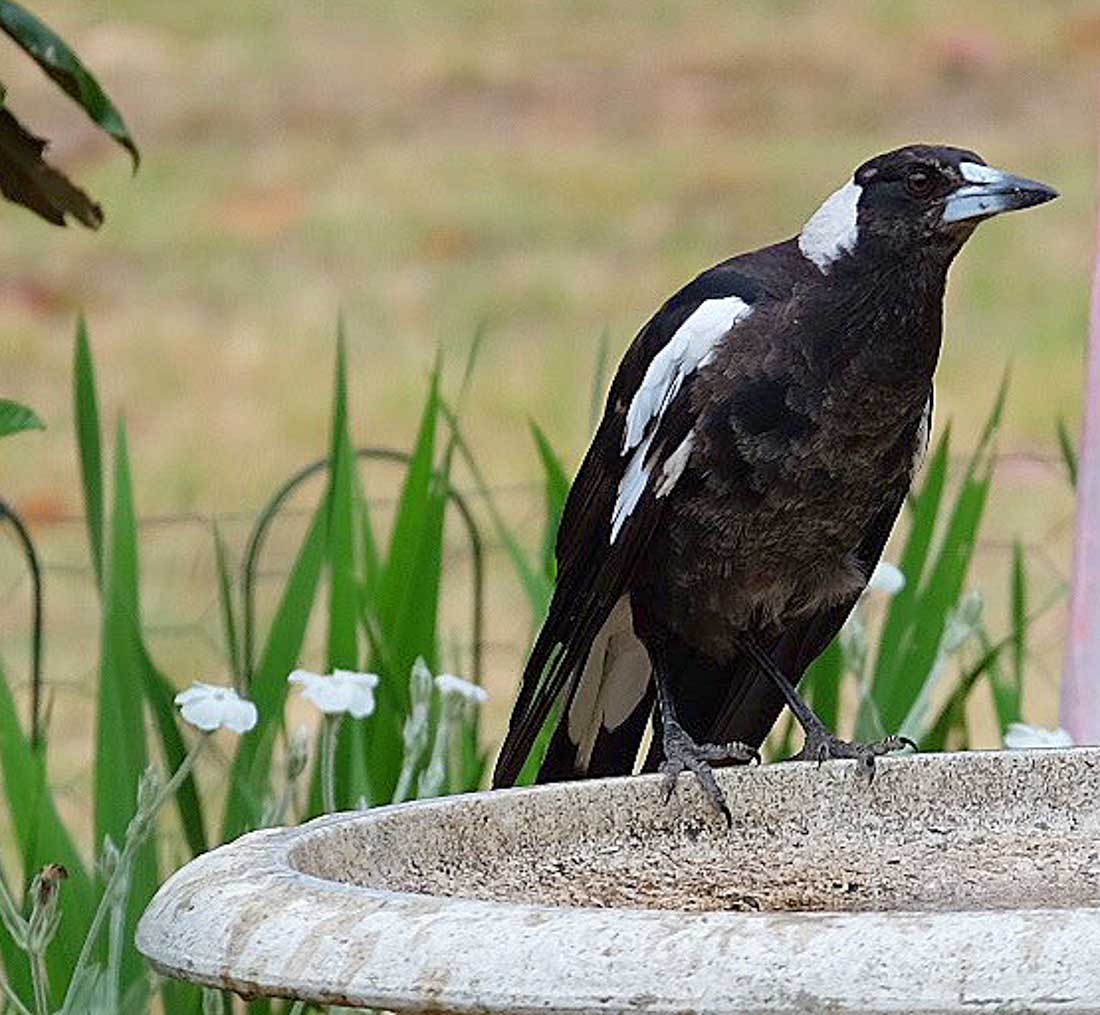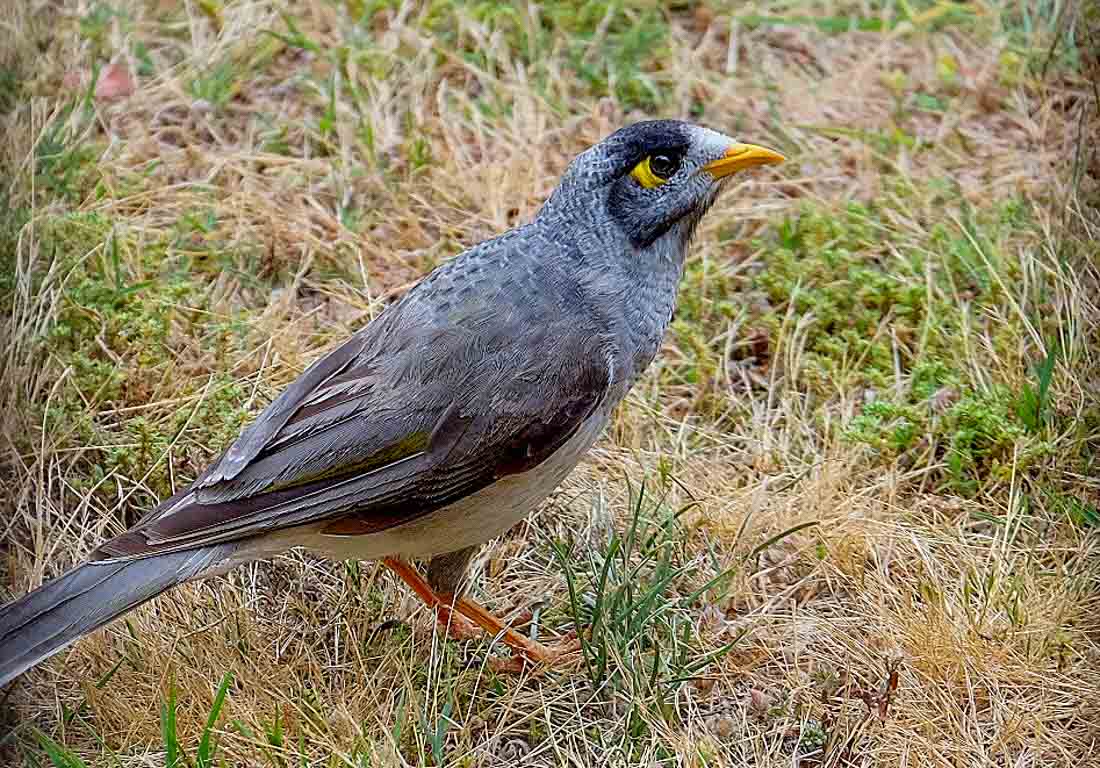Here at Canyonleigh in the New South Wales Southern Highlands, we are lucky to be situated within the Greater Eastern Wildlife Corridor. Many birds use this haven to migrate annually, and often these visitors will stop and take a bath or a drink in our garden.
I like to keep the birdbath topped up with fresh rainwater. As soon as I have cleaned and refilled it, in they come!

Yellow Tailed Black Cockatoo
The crest seems to reflect the bird’s emotions. When it is excited or alarmed, the feathers will be fully extended, reaching far forward over the bird’s head. A bird at rest, or one which doesn’t feel well, will have its crest feathers flattened against the back of its head.
The most shy of these birds is the beautiful yellow-tailed black cockatoo, a large parrot-beaked bird with stunning brown-black plumage, highlighted with patches of yellow on its cheeks, tail, and outstretched wings.

Magpie
Then there’s the ever-present magpie with its black and white plumage; juveniles have mottled grey feathers. This intriguing bird has a melodic birdsong, one of the bird world’s most haunting and lilting calls. Magpies often strut on the grass and tilt their heads, as if listening for the presence of edible lawn grubs.
The Australian magpie is a medium-sized black and white passerine bird that is native to Australia and southern New Guinea. Although it was once considered to be three separate species, it is now considered to be one, with nine recognised subspecies. The average life span is roughly 25 years.
The adult Australian magpie is a fairly robust bird ranging from 37 to 43 cm (14.5 to 17 in) in length, with distinctive black and white plumage, gold brown eyes and a solid wedge-shaped bluish-white and black bill.
Australian Magpie male and female appearance
The male and female are similar in appearance, and can be distinguished by differences in back markings. The male has pure white feathers on the back of the head and the female has white blending to grey feathers on the back of the head.
With its long legs, the Australian magpie walks rather than waddles or hops and spends much time on the ground.

Sulphur-crested cockatoo
Undoubtedly the most destructive and cheeky visitors are the sulphur-crested cockatoos, a large white bird with parrot beak. It has an expandable bright yellow crest, with delicate yellow tones under its wings and tail.
Cockatoos can occur in large “gangs”; able to make short work of crops on fruiting trees, as well as nibbling new growth from large eucalyptus on the forest’s edge.
The scientific name is Cacatua galerita which means ‘capped cockatoo’. Kakatua is the Indonesian word for a cockatoo, and the species name derives from the Latin galer meaning cap, referring to the bright yellow crest. The Sulphur-crested Cockatoos are members of the Psittacidae family of birds, or the ‘true’ parrots.
All have stocky bodies, medium-sized wings, strong, hooked beaks, and feet that have two forward-facing and two rear-facing toes.
Male and female sulphur crested cockatoo the difference
Male and female Sulphur Crested Cockatoos look very much alike; it is only up close and in strong light that you might notice the difference. The eye of the female has a lighter, reddish-coloured iris.
Males have very dark brown irises. From a distance, eyes of all birds look black. Males have slightly larger heads, and stand taller than females, but the birds have to be seen in pairs for this difference to be noticeable.
What is the lifespan of a sulphur-crested cockatoo in captivity opposed to in the wild?
Sulphur-crested Cockatoos usually reach sexual maturity at about six or seven years of age. They are known to live several decades in the wild, and are known to live to close to one hundred years old in captivity.

Noisy Minor Bird
An ever-present fixture is the noisy miner bird, a native who lets everyone know its presence with a raucous array of noises, especially useful in alerting us to the presence of many kinds of dangerous reptiles.
The bird bath is at times rimmed with a group of them, all vying for the first dip.
The Noisy Miner (Manorina melanocephala) is predominantly grey. Noisy miners have a black crown and cheeks, yellow bill and have naked skin around the eyes and legs.
Noisy Miners are native Australian honeyeaters and they are often confused with the Common or Indian Myna. The Common Myna is a brown bird of around the same size, with a black head, and is an introduced species of starling.
Why the name?
The noisy minor bird has a very loud call that sounds like a repetitive ‘pwee, pwee, pwee‘. When they want to warn other birds about possible dangers, their calls become even louder and higher pitched, creating quite a ruckus.
While sometimes annoying for us, these guys are amazing communicators and can quickly convey important information to the whole family group.
Diet
Noisy Miners have a big appetite and they will eat all kinds of food. They are technically a type of honeyeater and love to eat nectar, but they will also eat, seeds, fruits, insects, frogs, lizards, and just about anything else. Their ability to eat so many different food sources might explain why they like to live close to us in built up areas.
Conclusion
With such a beautiful variety of garden birds in New South Wales, Australia, it is fascinating to see them in the garden and have an opportunity to watch their unique behaviour and enjoy these wonderful visitors every time they make an appearance in the garden.








